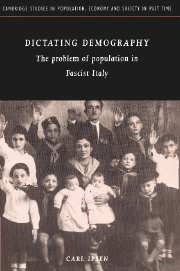Book contents
- Frontmatter
- Contents
- List of figures
- List of tables
- Acknowledgments
- Table for lira conversion to 1990 $US
- List of abbreviations
- Introduction
- 1 The background: Fascism, European population policy, European demography, and the problem of population in Liberal Italy
- 2 The organization of totalitarian demography
- 3 The realization of totalitarian demography I: Spatial population management
- 4 The realization of totalitarian demography II: Quantitative and qualitative population management
- 5 The measurement of totalitarian demography
- Conclusion
- Bibliography
- Index
- Cambridge Studies in Population, Economy and Society in Past Time
5 - The measurement of totalitarian demography
Published online by Cambridge University Press: 09 November 2009
- Frontmatter
- Contents
- List of figures
- List of tables
- Acknowledgments
- Table for lira conversion to 1990 $US
- List of abbreviations
- Introduction
- 1 The background: Fascism, European population policy, European demography, and the problem of population in Liberal Italy
- 2 The organization of totalitarian demography
- 3 The realization of totalitarian demography I: Spatial population management
- 4 The realization of totalitarian demography II: Quantitative and qualitative population management
- 5 The measurement of totalitarian demography
- Conclusion
- Bibliography
- Index
- Cambridge Studies in Population, Economy and Society in Past Time
Summary
The creation of a new Italian statistics institute in 1926 bore witness to the enhanced status and importance Mussolini and the Fascist regime assigned to the collection of “arid figures.” And the increased official attention and scrutiny devoted to statistics meant that they reflected official needs and priorities even more than they had in the Liberal period (see chapter 1, pp. 37–40 above). In this chapter I shall consider the way in which demographic policy manifested itself in the activities and publications of ISTAT, and also in the theoretical work of demographers. As practitioners of a decidedly political science, many demographers had formal ties to the government via ISTAT, UCD, and other institutions, and also in their capacity as university professors.
Population statistics
Chapter 2, pp. 78–87, above describes the creation of ISTAT and the relation of this institution and its president to the enunciation of demographic policy. Throughout the ventennio, ISTAT would be the primary source of demographic data for the government and for professional demographers pursuing and monitoring that policy. By means of censuses, the compilation of population registry data, and special surveys, ISTAT was expected to provide both a measure of the efficacy of demographic policy and an indication of the areas most needing attention. Greater official interest and support during the Fascist period translated into a significant improvement in the quality of Italian statistics, and examination of statistical emphases and lacunae as well as a series of changing definitions and methods of data gathering reveal that Fascist statistical interest and population policy strongly influenced the gathering and presentation of that statistical data.
The initial period during which Gini was president of ISTAT stretched from the institute's creation in July 1926 to Gini's resignation in February 1932.
- Type
- Chapter
- Information
- Dictating DemographyThe Problem of Population in Fascist Italy, pp. 195 - 252Publisher: Cambridge University PressPrint publication year: 1996



